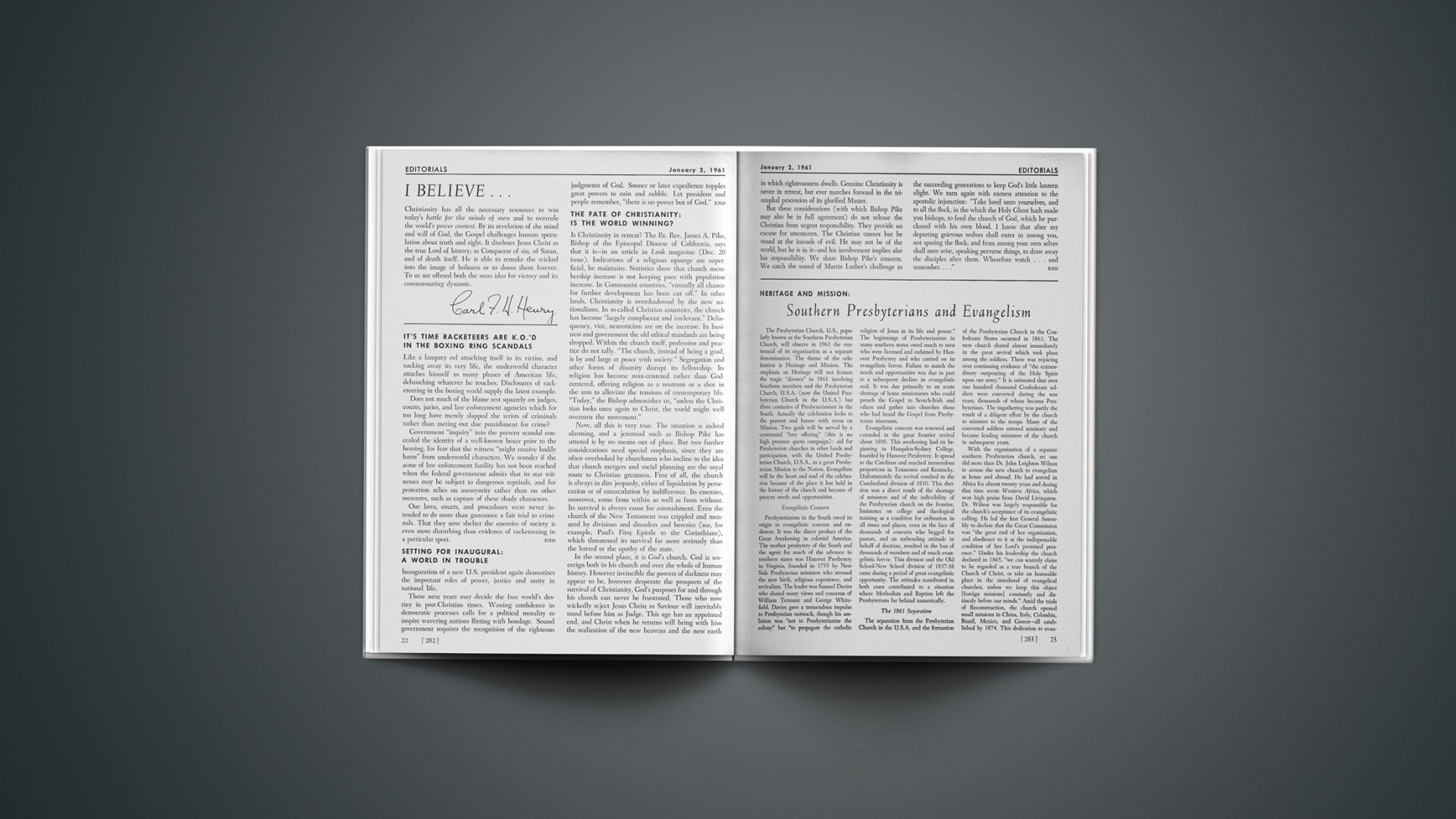The Presbyterian Church, U.S., popularly known as the Southern Presbyterian Church, will observe in 1961 the centennial of its organization as a separate denomination. The theme of the celebration is Heritage and Mission. The emphasis on Heritage will not feature the tragic “divorce” in 1861 involving Southern members and the Presbyterian Church, U.S.A. (now the United Presbyterian Church in the U.S.A.) but three centuries of Presbyterianism in the South. Actually the celebration looks to the present and future with stress on Mission. Two goals will be served by a centennial “love offering” (this is no high pressure quota campaign): aid for Presbyterian churches in other lands and participation, with the United Presbyterian Church, U.S.A., in a great Presbyterian Mission to the Nation. Evangelism will be the heart and soul of the celebration because of the place it has held in the history of the church and because of present needs and opportunities.
Evangelistic Concern
Presbyterianism in the South owed its origin to evangelistic concern and endeavor. It was the direct product of the Great Awakening in colonial America. The mother presbytery of the South and the agent for much of the advance in southern states was Hanover Presbytery in Virginia, founded in 1755 by New Side Presbyterian ministers who stressed the new birth, religious experience, and revivalism. The leader was Samuel Davies who shared many views and concerns of William Tennant and George Whitefield. Davies gave a tremendous impulse to Presbyterian outreach, though his ambition was “not to Presbyterianize the colony” but “to propagate the catholic religion of Jesus in its life and power.” The beginnings of Presbyterianism in many southern states owed much to men who were licensed and ordained by Hanover Presbytery and who carried on its evangelistic fervor. Failure to match the needs and opportunities was due in part to a subsequent decline in evangelistic zeal. It was due primarily to an acute shortage of home missionaries who could preach the Gospel to Scotch-Irish and others and gather into churches those who had heard the Gospel from Presbyterian itinerants.
Evangelistic concern was renewed and extended in the great frontier revival about 1800. This awakening had its beginning in Hampden-Sydney College, founded by Hanover Presbytery. It spread to the Carolinas and reached tremendous proportions in Tennessee and Kentucky. Unfortunately the revival resulted in the Cumberland division of 1810. This division was a direct result of the shortage of ministers and of the inflexibility of the Presbyterian church on the frontier. Insistence on college and theological training as a condition for ordination in all times and places, even in the face of thousands of converts who begged for pastors, and an unbending attitude in behalf of doctrine, resulted in the loss of thousands of members and of much evangelistic fervor. This division and the Old School-New School division of 1837–38 came during a period of great evangelistic opportunity. The attitudes manifested in both cases contributed to a situation where Methodists and Baptists left the Presbyterians far behind numerically.
The 1861 Separation
The separation from the Presbyterian Church in the U.S.A. and the formation of the Presbyterian Church in the Confederate States occurred in 1861. The new church shared almost immediately in the great revival which took place among the soldiers. There was rejoicing over continuing evidence of “the extraordinary outpouring of the Holy Spirit upon our army.” It is estimated that over one hundred thousand Confederate soldiers were converted during the war years, thousands of whom became Presbyterians. The ingathering was partly the result of a diligent effort by the church to minister to the troops. Many of the converted soldiers entered seminary and became leading ministers of the church in subsequent years.
With the organization of a separate southern Presbyterian church, no one did more than Dr. John Leighton Wilson to arouse the new church to evangelism at home and abroad. He had served in Africa for almost twenty years and during that time wrote Western Africa, which won high praise from David Livingston. Dr. Wilson was largely responsible for the church’s acceptance of its evangelistic calling. He led the first General Assembly to declare that the Great Commission was “the great end of her organization, and obedience to it as the indispensable condition of her Lord’s promised presence.” Under his leadership the church declared in 1865, “we can scarcely claim to be regarded as a true branch of the Church of Christ, or take an honorable place in the sisterhood of evangelical churches, unless we keep this object [foreign missions] constantly and distinctly before our minds.” Amid the trials of Reconstruction, the church opened small missions in China, Italy, Colombia, Brazil, Mexico, and Greece—all established by 1874. This dedication to evangelism abroad has continued among Southern Presbyterians. The proportion of missionaries to membership is greater today than that in almost all major denominations, and the size of the foreign mission program is surpassed by only a few American churches.
In recent decades three developments may be mentioned. The period 1908–1918 reflected increased evangelistic concern. The beginnings of a special department of evangelism date from 1908. A permanent committee of evangelism for the General Assembly was appointed which thereby promoted an evangelistic committee in each presbytery. In addition to that, an Assembly evangelist was used. J. Wilbur Chapman, R. A. Torrey, and Billy Sunday were heard in many revivals. In 1915, there was “the evangelistic Assembly.” While much emphasis was placed on professional evangelism, and while evangelism appeared to be largely conceived in terms of revival meetings, the ideal was kept before the members and was given a place in the organizational structure of the church.
Second, a new evangelistic concern developed in the 1930s which led to a rededication to evangelism in 1939. This resulted in the greatest period of growth, from 1940–1960, that the church has known. It stressed witness as the business of every church and of every Christian. A great number of outpost Sunday Schools and chapels were established which led to the organization of an average of one new congregation each week. New members, which were added on profession of faith, increased from 16,000 in 1938 to almost 30,000 in 1958. In many states Presbyterian growth was at a much faster rate than population gain. The technique of visitation evangelism found wide acceptance.
Third, there has been in recent years a deepening and broadening of the concept of evangelism. A greatly strengthened Division of Evangelism in the Board of Church Extension is leading the way. There has been serious search, still in process, for a concept of evangelism consistent with Reformed theology. Evangelistic techniques, ancient and modern, have been evaluated in the light of theological understanding. Along with promotion of evangelism by spoken word is an emphasis on evangelism by Christian action. It is interesting to note that about the same time the church’s rededication to evangelism occurred, there took place the establishment of a permanent committee on Christian Relations. The evangelistic program now joins individual outreach with concern for society. Materials issued by the Division of Evangelism encourage community study, Christian social responsibility, and involvement in crucial world issues. At the same time there is increasing stress on the church and on the importance of the life and worship of the local congregation. This emphasis reflects the attention given by the Board of Christian Education to the study of the “Covenant Community.” It is the judgment of the writer that evangelism is gaining in the Southern church a new place of acceptance and standing, especially among those ministers who had disdained an over-emphasis on techniques and results. The Southern church has not known an evangelistic program so extensive or so carefully prepared as the Presbyterian Mission to the Nation.
Some Problems
There are some problems facing the church’s evangelistic concern. One persistent question in any consideration of evangelism among Southern Presbyterians relates to the Negro. Results of evangelistic work among the Negroes have been exceedingly small. Even in 1840, only about 7000 out of 250,000 Negro church members in the South were Presbyterians. The number decreased until in 1892 there were only about 1300 Negro members. The decline was due to many factors, the primary one being perhaps a lack of real concern. But there were those who had concern, as, for example, Dr. John L. Girardeau who was pastor of Zion Church, Charleston, South Carolina, and who led in the construction, for his Negro congregation, of the largest church building in that city. How to win the Negro and what was the best ecclesiastical relationship of Negro churches were discussed in many Assemblies. As early as 1867, the Assembly approved, if possibly only in theory, of ordaining men “of whatever race, color or civil condition.” In 1874 the Colored Evangelistic Fund was set up and in 1877 a school for Negroes, now Stillman College in Tuscaloosa, Alabama, was opened. The church experimented with a separate independent Negro Assembly, then for a quarter of a century it retained an all Negro synod, then it incorporated Negro ministers and churches in predominantly white presbyteries while allowing others, if they chose, to continue in Negro presbyteries. In recent years 2 million dollars was raised to strengthen Stillman College, purchase land and erect Negro churches. Negro ministers are trained in the church’s seminaries, and two of the church’s colleges have accepted a few Negro students. The new attitude in the church may account for the fact that in the last five years the number of Negro members has doubled.
The evangelism of the Negro is crucial. At present the Presbyterian Church, U.S., is surrounded by millions of Negroes but remains almost exclusively white in membership. With many Negroes unreached, and many others searching for a church life and worship more meaningful than what they have previously known, the opportunities are great. But the difficulties are also great. Several local efforts, undertaken with zeal and dedication by white ministers and churches, have seemed almost fruitless. The number of Negro ministers to serve newly gathered congregations is very small. A few white churches have accepted Negro members and other churches are on record that their membership is open to all regardless of race or color. Due to location as well as social and economic factors, it does not appear that the integration of white churches will be a means of greatly increasing Negro membership, at least for a few years. The establishment of new churches which are integrated from the day of their founding and which are located to serve both races offers some hope.
There is another group in the South where Presbyterian evangelistic endeavors and results have been small. These are the Mexicans, concentrated in the Southwest. In Texas a separate Mexican presbytery was abolished. A remarkable educational advance has been made in the new Presbyterian Pan-American School. But the number of Mexican ministers and churches is still very small. Effective evangelism among the Mexicans will demand more than zeal, unless it is zeal that is resourceful in developing new approaches.
A third area of evangelistic challenge is in the great industrial areas and among the lower income people. There have been some notable examples of pastors who have had remarkable ministry in industrial communities, but the number of them is not great. Signs of a growing consciousness in the church of the need to serve all the people of the South is hopeful. Transition from a predominantly upper middle class church to one with a large membership among the less privileged will challenge the evangelistic resourcefulness and zeal of the Presbyterian Church, U.S.
T. WATSON STREET
Professor of Church History
Austin Presbyterian Theological Seminary
Austin, Texas










